Read on to answer these questions and help you kill your character with conviction.
For more information on the process of dying see ‘Killing your character with conviction – Staring Death in the Face’
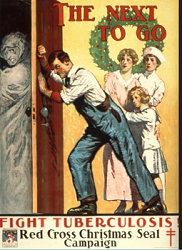
What is TB
Tuberculosis (TB), once known as consumption, is a bacterial infection spread through inhaling tiny droplets from the coughs or sneezes of an infected person. The released infection can stay airborne for hours. TB mainly affects the lungs, but once inhaled the infection can spread through the body via the bloodstream.
There are many kinds of TB, mainly catagorised by where in the body the infection inflicts the damage. Non lung TB is a general term for TB that doesn’t originate in the lungs. Bovine TB can be spread to humans via infected dairy products and carried by the gut.
Fact: Today two thirds of the Worlds population are infected with TB.
Why your character dies
TB destroys the lungs from the inside, eating the lung away and replacing it with blood and liquefied tissue. Your character drowns in the remains of their lungs.
The same destructive infection can be spread through the body causing fatal Cardiac Tamponade (fluid in the heart), liver failure and TB meningitis affecting the brain and spinal cord.
The infection can affect the tissue covering around the lung (the pleura, causing inflammation known as pleurisy), as well as the skin, bones, lymph nodes in the throat, urinary tract, bowels, sexual organs and nervous system. The nasties appear in different forms, generally as granular deposits, nodes and abscesses in and on organs. In bones these nasties eat into soft tissue (cartilage etc) before moving onto the harder stuff.
TB in the bones happens in the weight bearing joints and spine causing the tissue to die. In Potts disease the spine collapses sometimes leading to spinal compression, paraplegia and hump (a gibbus)
On the skin it appears as a range wonderfully named warts, lesions and ulcers on the knees, elbows, hands, feet, face, calves and neck, such as Prosecutors Wart, Lupus Vulgaris, Scrofula (Kings evil) and Bazins disease.
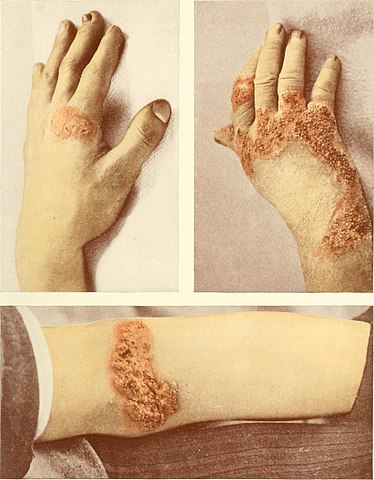

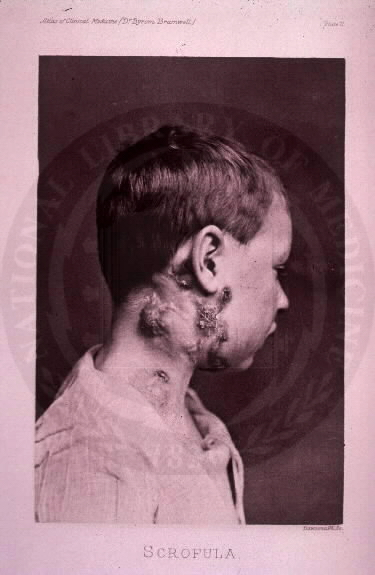
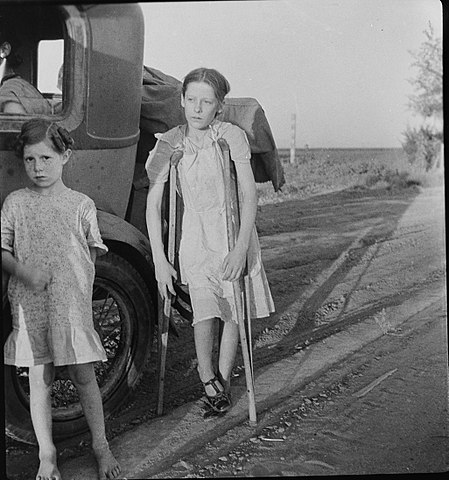
Prosecutors Warts
Lupus Vulgaris
Scrofula
Spinal TB
How TB Develops
Around 6 weeks after being inhaled into the lungs the infection develops and can be spread without showing any symptoms if the immune system is healthy (latent TB). Months or years later if the immune system is compromised the infection can reactivate anywhere in the body, but generally in the lungs.
“The TB infection takes 6 weeks to develop, but can remain latent for 20 years”
TB is concentrated mainly in developing countries and countries where there is malnutrition, poverty, poor health and social disruption. It does however exist in the UK among social alcoholics, healthcare workers and those who are HIV-positive.
A persistent cough that lasts more than three weeks and usually brings up phlegm, which may be bloody.
Weight loss
Tiredness and fatigue.
Symptoms of the spread of TB:-
Swelling in the neck
Fits or seizures
Pain of loss of movement in the joints
Loss of appetite
Headache
Abdominal pain
Confusion
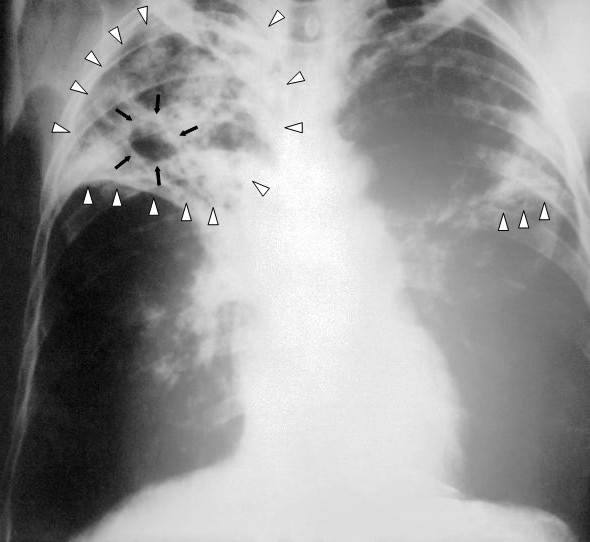
TB can cause chronic pneumonia. The cause and symptoms of both are not dissimilar and can lead to an initial misdiagnosis.
The treatment for TB is long term multiple antiobiotics (over 6-9 months)
In addition to being in contact with a person who has active TB, other risk factors for TB infection include:
- HIV infection, diabetes, certain cancers, and other conditions that weaken the immune system such as drug and alcohol abuse.
- Traveling to, living in, or immigrating from areas of the world with high rates of TB, including Latin America, Africa, Asia, and Russia
- Living or working in a location where TB is more common, including prisons, homeless shelters, immigration centers, nursing homes, and healthcare facilities.
- Having had a Gastric Bypass or Gastroectomy
- Existing chronic disease such as Sillicosis (damage to the lungs from breathing in sillica dust) or Celiac disease (autoimmune disorder of the intestine)
- The homeless or those living in poor conditions
The choice of TB as a vehicle to kill off a character is not only perhaps the most unpredictable and gruesome, but also the most currently relevant.
THE END
All Rights Reserved
References :-
https://www.nhs.uk/conditions/Tuberculosis/Pages/Introduction.aspx
https://www.blf.org.uk/support-for-you/tuberculosis/what-is-it
http://www.netdoctor.co.uk/conditions/infections/a5682/tuberculosis-info/
https://medlineplus.gov/ency/article/000624.htm
https://www.nhs.uk/Conditions/Tuberculosis/Pages/Symptoms.aspx
https://www.everydayhealth.com/tuberculosis/death-from-a-preventable-disease.aspxhttps://www.msf.org.uk/issues/tuberculosis

